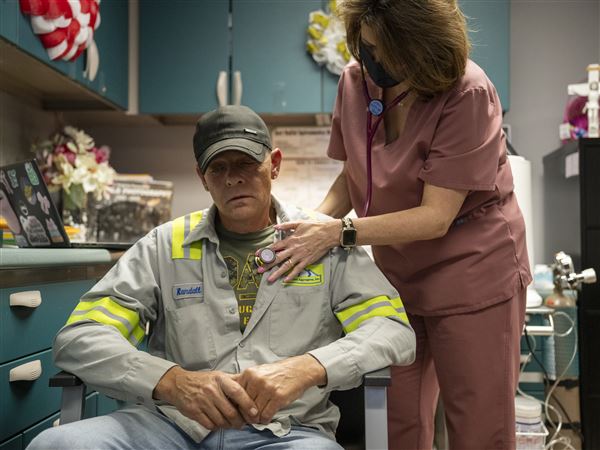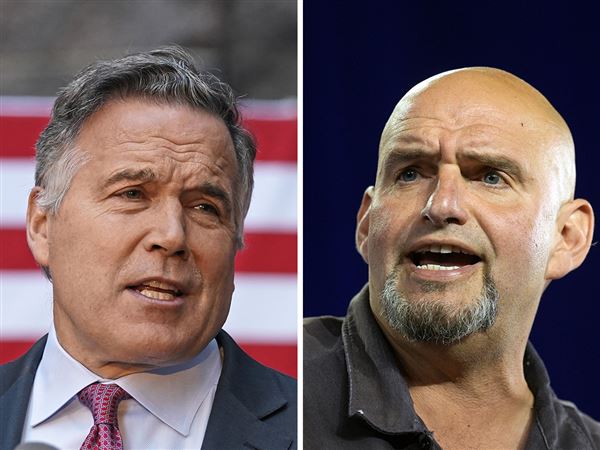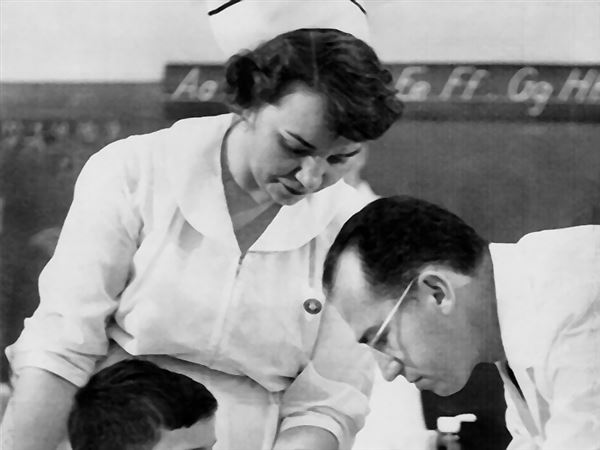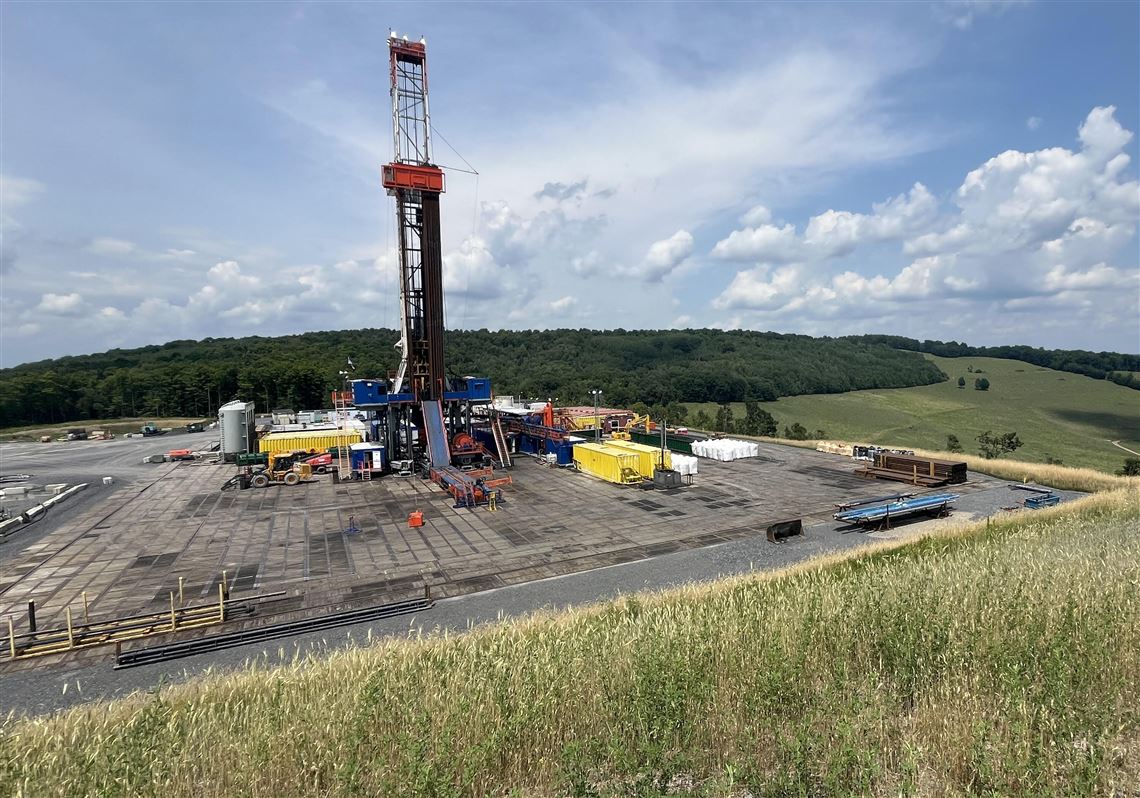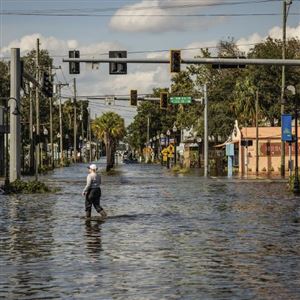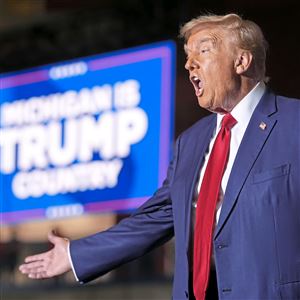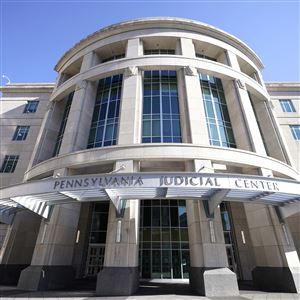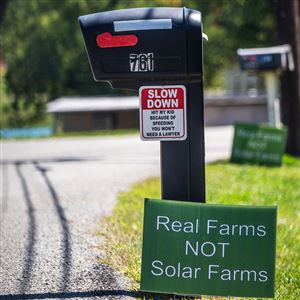Presidential candidates Donald Trump and Kamala Harris have addressed the topic of fracking in nearly every speech they’ve given in Pennsylvania over the past few months — including the debate hosted in Philadelphia — because the issue has far-reaching implications for voters, particularly in the Keystone State where there are thousands of gas wells. But it’s not just about wells; it’s about other issues, too — such as rural economies, the state budget and finding the right posture for traditional constituencies who aren’t necessarily where one might expect them to be.
With Pennsylvania — and its 19 Electoral College votes — a must-win for both candidates this year, the politics of fracking are both complex and unavoidable.
Fracking is shorthand for hydraulic fracturing — the process by which natural gas is extracted from underground. Though regulations for the industry are often set at the state and local levels, many voters are particularly interested in what the future president thinks — and the broad impacts their stated policies could have on the industry.
Trump and Ms. Harris have addressed the topic multiple times. Trump has claimed, based on statements she made in 2019, that Ms. Harris wants to ban the practice — while Ms. Harris and her campaign have said she no longer supports a ban and note that she cast the tiebreaking vote on legislation that expanded federal leases for fracking.
What candidates say on the campaign trail tends to be more of a political posture than actual practice. Whoever is elected doesn’t have the unilateral power to ban fracking. That would require action by Congress.
Additionally, a ban from the federal government would only stop fracking on federal land — about 11% of the country’s natural gas comes from wells on federal land, according to the American Petroleum Institute. The majority of fracking in the U.S. is done on private or state land, including in Pennsylvania.
By contrast, Trump at most rallies has been touting his fracking motto “drill baby drill,” a phrase borrowed from former Alaska Gov. Sarah Palin, as a show of support to the industry.
The upcoming election was a visible undertone at this year’s “Shale Insights” oil and gas industry conference in Erie, with many of the speakers mentioning the industry’s prominence in presidential speeches.
David Callahan, president of the Marcellus Shale Coalition, said during the conference there’s no reason that fracking should be political because the benefits — both direct and indirect — cut across party lines.
For politicians, though, the topic is used symbolically to signal stances on various economic and social issues to different constituencies, according to Berwood Yost, the director of the Floyd Institute for Public Policy and Center for Opinion Research at Franklin & Marshall College.
Both sides of the aisle signal in different ways, he said.
For the Trump campaign, “it works in multiple ways,” Mr. Yost said. “One level is talking about economic performance and growth. On the second level, it’s sort of poking at this idea of the Green New Deal, green environmentalism that hurts extractive industries.”
The Harris campaign “sees their vulnerability on the issue among certain segments of voters and wants to neutralize it as an issue,” he said, referring to environmental groups that are likely to vote Democrat, but have concerns with drilling for natural gas.
Despite the increased rhetoric surrounding fracking in Pennsylvania by the presidential candidates, opinions and the response to fracking itself is “asymmetric,” Mr. Yost said, depending on where in Pennsylvania one lives.
In the southeastern part of the state, many people are against fracking, but “if it doesn’t get banned, it doesn’t really affect their day-to-day lives,” he said.
But in southwestern Pennsylvania, where fracking for natural gas was first successfully proven 20 years ago this month and where thousands of wells — and many of the companies that service them — are now located, a ban would drastically impact the daily lives of people who live there.
“So you feel much more intensely about it in those other parts of the state,” Mr. Yost said.
For many in the industry and those in opposition, the politicization of fracking boils down to three key points: climate change, economic impact and jobs.
Climate change
A major concern of both the oil and gas industry and its opponents is the impact drilling, fracking especially, has on the climate.
To extract natural gas via fracking, engineers drill vertically down into the ground and then horizontally for a much as 2 miles or more out through the comparatively thin layer of shale rock. Large quantities of water and sand are then pumped into the shale at high pressure to fracture it, which releases the gas trapped there; the sand props the fissures open so the gas continues to flow.
While there are concerns about the high water usage, impact on local water wells, and the industrialization of undeveloped land, many of the environmental and political concerns over fracking boil down to the use of fossil fuels, which drive global warming.
Environmental activists have been advocating for a shift away from fossil fuels to renewable energy sources such as solar or wind.
The criticism of the use of fossil fuels and fracking is that burning them releases greenhouse gasses like carbon dioxide into the atmosphere; yet, of all the fossil fuels, natural gas emits the least amount of carbon dioxide when burning.
Because of that, many in the industry refer to it as a “bridge fuel,” meaning that while various entities make the shift to renewable energy, they will use natural gas because it has the least impact on the climate.
“Dispatchable power from natural gas is essential to complement intermittent sources of power when the sun doesn't shine and the wind doesn't blow,” Mr. Callahan said. “Abundant natural gas is a desirable source for clean hydrogen and sustainable aviation fuels, among other products that support a cleaner economy.”
However, environmental groups, like the Sierra Club, argue that natural gas isn’t a bridge fuel because of the chance for methane gas — which is more damaging to the climate in the short term than carbon dioxide — to leak during production or from wells that are abandoned or improperly sealed. Pennsylvania is estimated to have more than 200,000 abandoned wells dating back more than a century.
The issue currently with renewable energy, according to those supportive of the oil and gas industry, is its variability and weather dependency.
“None of us are against renewables,” said Thomas Jorden, the president and CEO of Coterra Energy. “Bring them on, but bring them on in the interest of data-driven good policy.”
He noted that last year, all seven of the swing states, including Pennsylvania, had natural gas as their largest energy source and that currently renewable energy cannot meet that demand.
“Fracking is a necessary part of our ‘all the above’ energy solution going forward,” said Lisa McManus, vice president of legal and general counsel for Pennsylvania General Energy. “I am very much a proponent of other sources of energy being in the mix as well, but until we get to a point where we have a renewable source that is completely reliable and affordable, I think that natural gas is going to be a part of what our nation needs to be energy independent.”
Economic impact
Like many other political topics in this year’s presidential race, the argument over fracking also boils down to money and how it impacts the economy.
Broadly, because the U.S. extracts more natural gas than it uses, the country no longer has to import the gas from other countries.
“The shale revolution has been nothing short of transformative, offering tremendous economic benefits to not only our basin, but our country and our world,” Mr. Callahan, of the Marcellus Shale Coalition, which represents various industry-related companies in Pennsylvania.
And in Pennsylvania, the economic impact is felt directly in people’s bank accounts.
Many wells in the commonwealth are located on farm land. Those farmers have seen an economic boost on two fronts: one from the initial money they get for leasing the land and again when they are paid royalties on the gas that’s being sold.
In a time when farmers, particularly small family farms, are closing down because of high costs and low margins, that money often allows the business to stay afloat — helping farmers pay for new equipment, hire more help or buy more land to expand the farm. In some instances, it allows them to secure loans to pursue new ag-related business ventures.
The state itself also makes money from fracking operations through taxes and the land it leases to the industry.
In 2023, Pennsylvania’s tax on natural gas production generated $179.6 million, according to the Pennsylvania Public Utility Commission. A portion of that money goes to the Pennsylvania Game Commission, which in turn funds land and habitat preservation on state game lands, road and infrastructure updates and outdoor recreational facilities among other things.
The state also collects an annual impact fee on natural gas wells that were drilled or operating in the previous calendar year.
Last year, the state collected about $174 million from those fees, the majority of which are paid out to counties and municipalities to offset the adverse impact of gas drilling on local infrastructure. Many local governments use this money for things like road repair.
Similar to farmers, the state also makes royalties off the land it leases to the drilling companies.
More than 250,000 acres of state land has been leased to private industry and multiple estimates believe the state has made over $1 billion on the leases since 2008, when then-Gov. Ed Rendell made the controversial decision to allow leasing state land for drilling.
All that money paid out to state and private entities, Ms. McManus at PGE said, “unites political opposites” when it comes to the topic of fracking.
“We hear in every corner, in every community in Pennsylvania, natural gas bridges political divides,” she said at the Shale Insight conference.
Jobs
The other major reason candidates have been focused on fracking is the jobs it creates.
Politicians, particularly presidents, tend to campaign heavily on jobs and use jobs numbers as a contrast to the unemployment rate, and using both at times as signifiers for how the economy is doing. If job creation is high and unemployment low, most people tend to believe the economy is in a good place.
“Fracking is on the forefront [of politics] because of the jobs,” said Debra Smit with the Breathe Project, a local environmentalist group pushing to transition away from fossil fuels.
“Given the number of family-sustaining jobs that we have in the commonwealth, [fracking] is an important part of the conversation because if it were to go away, it would impact us … from the standpoint of all those jobs,” Ms. McManus said.
But it’s difficult to nail down just how many jobs the industry has created, in part because different studies use different definitions. Many studies from the industry include “indirect” or “induced jobs,” which on some occasions include if restaurants near new wells have to hire more staff due to increased business as a result of the well.
Most reasonable estimates put the number of jobs in Pennsylvania involved in the gas industry at around 100,000.
Mr. Callahan called the industry a “prime catalyst for sustained economic growth and meaningful job creation.” However, with the decrease in the price of natural gas that came with increased production, some drilling operations have paused, putting some workers out of jobs.
Advocates for renewable energy sources, like Ms. Smit, believe that transitioning away from fossil fuels would not only preserve the jobs already in that sector, but could “create even more jobs by bringing in other manufacturing groups.”
The Brookings Institute in 2021 released a report recommending that governments attempting to transition to cleaner energy sources should focus on retraining those who already work in the fossil fuel industry as a way to avoid losing jobs, although it’s still not entirely clear how many jobs the transition could eliminate or create.
First Published: October 8, 2024, 9:30 a.m.
Updated: October 8, 2024, 6:13 p.m.
